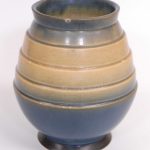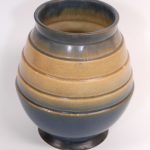American art pottery is one of our owner Michael’s very favorite types of object to restore. Each studio had its own distinct style that would evolve throughout the late 19th and early 20th centuries. The molded stoneware, low relief, and incised decoration was a carefully crafted backdrop for glazes that would highlight the form and texture of the pottery.
This Roseville vase was manufactured in the late 1920s as part of the Futura pattern. Perhaps it is a more modest example of the Art Deco style, but it is representative of Roseville’s aesthetic and remains highly collectible.
It is a joy to do an invisible restoration on a piece with such texture and variation in the glaze, but it isn’t always warranted. Many times a collector will opt to make a restoration just inconspicuous enough so as not to draw one’s attention away from the piece as a whole. This is far more cost effective and results in a restoration more commonly found on museum pieces. Take a closer look at some of the pottery at your favorite art museum you’ll likely be able to spot a restoration or two. Thankfully, the variation of texture and color on a piece such as this helps to obscure a less-than-invisible restoration. Now it can be enjoyed on display with the rest of the collection.






